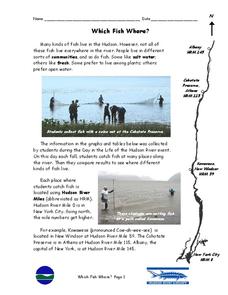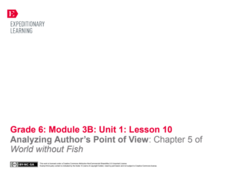Illustrative Mathematics
Teen Go Fish
Kindergartners play the classic game Go Fish as they practice identifying numbers in the teens. A fun and engaging activity that develops number recognition skills in young learners. As added support, provide cards that include both the...
Curated OER
Sorting Fish by Number
Go fish! Kindergartners match numbers between fishermen and the fish they're catching. Once kids finish their number practice, they can color the page. For extra fun, bring in plastic fish with numbers, and assign numbers to kids to...
Curated OER
Which Fish Where?
Focusing on the fish in the Hudson River Estuary, this activity could be used to practice reading, graphing ,and critical-thinking skills. Answering the 6 questions should be interesting for students due to the interesting subject matter.
Consortium for Ocean Science Exploration and Engagement (COSEE)
Fish Morphology
Life comes in all different shapes and sizes, and fish are no exception. Here, young scientists create fish prints as they learn how specific characteristics allow different species to survive in their particular habitats.
Curated OER
Go Fish
Help learners discover methods to estimate animal population. They will participate in a simulation of catching and tagging fish in order to estimate the fish population. They scoop and count goldfish crackers, record data, and use...
CK-12 Foundation
Whole Number Addition: Let's Go Fishing!
Practice adding whole numbers by combining the amount of fish Alice and Bob catch. As young mathematicians work through each problem, they are asked to find one more plus the amount of fish already caught. They can manipulate the...
Curated OER
Rainbow Fish Drawing
First graders read the book, RAINBOW FISH and view a few pictures of different types of fish. They discuss putting certain shapes together make up objects and talk about and demonstrate straight and wavy lines, thick and thin lines....
Curated OER
Number Line Snacks: Compare Numbers to 10
Kindergarteners put Cheerios or cheddar fish on two number lines (up to 10 each) and identify which number the snack pieces indicate. They compare numbers after eating a few of each snack, and get an introduction to addition and...
Curated OER
Numbers and Counting
Students explore the numbers one through five. Over a three week period, students visit centers in the room to investigate and perform hands-on activities with numbers. They trace numbers, write numbers in shaving cream, count objects,...
Curated OER
Fishbowl Counting
Young mathematicians demonstrate their understanding of cardinality with this simple math worksheet. Given a series of ten empty fishbowls, learners are asked to draw in the number of fish indicated on each bowl.
Curated OER
Study Buddies: Multiplying by Two-Digit Numbers
Learners solve a multiplication problem in which they must multiply two 2-digit numbers with the help of a "Coach". Pupils follow a step-by step process and notes are provided for the coach.
EngageNY
Analyzing Author’s Point of View: Chapter 5 of World without Fish
That's an interesting perspective. Scholars read chapter five of World without Fish and use an Author’s Point of View graphic organizer to determine the author's perspective. In triads, they highlight words that support the author's...
Curated OER
Ordinal Numbers
In this mathematical ordinal numbers worksheet, students follow eleven directives on the grid shown to sort out where each item should go.
Savvas Learning
Missing Numbers
Young learners answer six fill in the blank questions where they determine the missing addends for four addition word problems. They fill in the missing numbers on a problem that involves both addition and subtraction. Lastly, they...
Curated OER
On the Trail of the Hudson's Migratory Fish
Using data related to the fish in the Hudson River area, learners calculate distance, elapsed time, and growth. They learn about migratory fish, the life cycle of a fish, analyze a map, and answer questions.
Curated OER
Reader's Rabbit Math
Students are able to use the Fishing for Numbers game in Reader Rabbit's Math. They are able to select two addends that sum to the given number between 1 and 12. Students work in pairs and go to the computer stations and complete at...
Curated OER
Build-A-Fish
Students identify the basic external anatomy of a fish. After identifying the parts of the fish, students explain the function of each body part and how it is related to the whole. They discover how the shape of a fish help to propel it...
Curated OER
Five Fish
Ideally, this resource would be used in a pre-school classroom to introduce the idea of counting to five. In the presentation, the numbers, word representations, and a graphic showing a certain number of fish, help review this...
Curated OER
Addition
Looking for some straightforward addition practice? You found it! Mathematicians calculate sums between double-digit addends, using examples as guidance. There are 12 problems total. Next, they answer two simple addition word problems....
Curated OER
Problem Solving
Give kids a few strategies to help them become amazing problem solvers. This presentation is intended to be used over a two-day period and presents several techniques or ways to solve word problems or multiplication problems by...
Curated OER
Fractions and Rationals
Upper elementary and middle schoolers solve 16 types of problems to include writing fractions to represent shaded portions, writing a mixed number to represent certain points on a number line, and changing equivalent mixed numbers to...
Curated OER
Further Investigating Greater Than, Less Than, and Equal to
Students investigate number relationships such as greater than, less than, and equal to. In this number relationship lesson, students use number mats and a fish with a large, open mouth to practice showing number relationships.
Mathwire
Seussical Fish
Wondering what Dr. Seuss and his colorful fish have to offer your young mathematicians? Find out with this simple yet affective word problem worksheet that challenges children to determine how many different combinations of toy fish can...
Curated OER
Numbers and Operations
Learners practice using proportions to discover the fraction needed to use the right amount of an ingredient. They calculate the number of ounces in one gallon as well. They answer questions to complete the lesson.

























